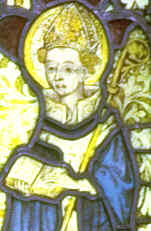
Site last updated 20/2/2016.
Welcome to new users of this site, and welcome back to those returning for another look. This site provides an introduction to medieval manuscripts through the medium of the arcane art of paleography, or the history and decoding of the forms of handwriting. Fear not! It is designed to be interesting and fun, based around interactive exercises cooked up from samples of old scripts in public collections or in the personal possession of myself or other helpful individuals. Some of the manuscripts are august and famous, and other are little scraps discarded by history. Some are beautiful and easy to read, and others are utterly horrible. Some are in Latin, and others in various vernaculars, including English.

Fragmentary stained glass panel of a bishop with a book from St Peter Hungate Museum, Norwich.
The topics in the left sidebar all lead on to various and growing discussions and resources. If you get totally lost, or are looking for a particular topic, or don't have the left frame displayed, try the site map. There is some general information on the topics covered and how it all works in a section on how you can use this website. You can also do Google search on the pages of this site. We have added our Medieval Church Glossary. The Elephant Book, our guide to medieval resources on the web, has been removed as it had become an elderly elephant.
Medieval manuscripts are not copyright, but the photographs taken of them are in many cases subject to copyright restriction. We have been fortunate in that the British Library and the National Archives have permitted us to reproduce a large number of manuscripts without fee to allow this project to go ahead. Various other institutions have also allowed us to use images in our possession from their manuscripts. Please respect their restrictions on copying and distribution of the images used, for the sake of all of us and the future of educational cybermedia.
Now that the British Library is allowing reproduction of images from their online catalogue under a Public Domain Mark, old black and white images are being replaced with elegant colour reproductions as they become available.
With the increasing commercialisation of the education industry, the World Wide Web is becoming a last resort for the dissemination of educational material without a hefty price tag attached. Let's try to keep it that way. Thus endeth the sermon.
EMAIL: Please feel free to email me with comments or queries. I enjoy hearing from users of the site, who appear to be a most diverse and interesting crew with fascinating hobbies and interests. Don't forget to include the words "medieval writing" or "manuscript" or "paleography" or suchlike in the subject line so that you don't get deleted along with the spam. Just remember that I cannot do authentications or valuations of manuscripts for sale, as I do not have the specific expertise and when it comes to digital imagery, pixels are just pixels! General queries are most welcome, but please ask before sending large graphic files and read this section on sending attachments. Looking forward to hearing from you.
Some thoughts and capacity for your input are now available on Dianne's Medieval Writing Blog and for those with a short attention span, tweeting as Hipster Bookfairy.
Latest Updates to Site :
A few link updates, otherwise all quiet as I catch up on some other projects.
There is now an Update Log to keep track of continuing developments.